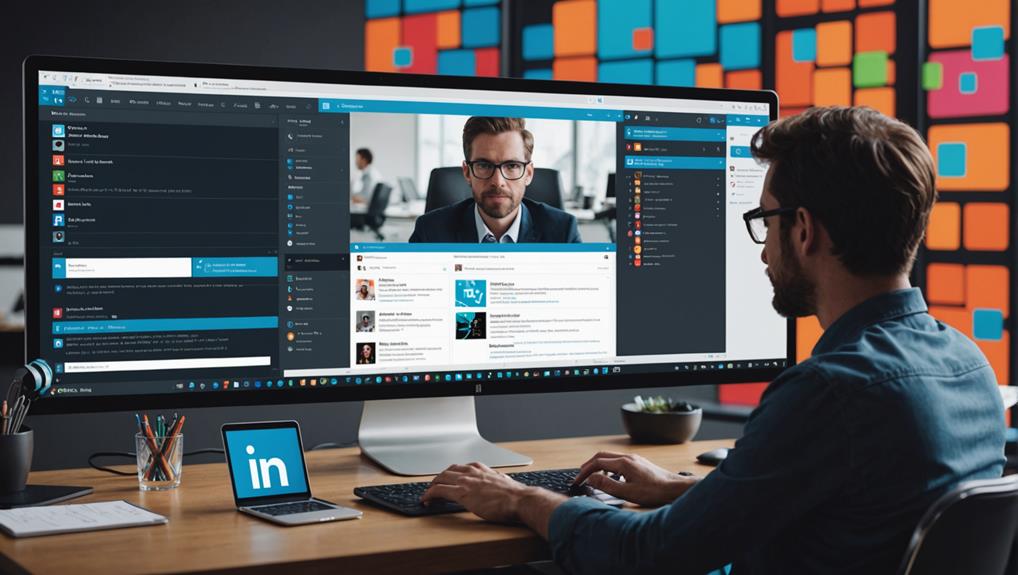
In today's fast-paced professional world, you've likely wondered how to sharpen your skills efficiently. LinkedIn, more than just a platform for networking, presents a unique opportunity for personal growth. By actively engaging with tailored posts, following the right influencers, and participating in discussions, you can transform your feed into a dynamic learning environment. Have you considered how these actions directly influence your career progression? Let's explore how strategically interacting with content on LinkedIn can not only fill your skill gaps but also open doors to new opportunities. What might you discover about your professional potential by making a few adjustments to your LinkedIn habits?
Identifying Skill Gaps

To identify skill gaps effectively, first assess your current abilities and compare them to the requirements of the job or role you aspire to.
Begin by listing the skills you currently possess and noting how proficient you're in each. Next, research the essential skills needed for your target position. This might involve reviewing job postings, speaking with industry professionals, or exploring company websites.
Once you have both lists, it's time to analyze where the discrepancies lie. Highlight the skills that you lack or need to improve. This comparison gives you a clear, actionable framework for what you need to learn or enhance.
Now, reflect on your findings. Ask yourself how these gaps might impact your career progression. Understanding the urgency and relevance of each skill gap will help you prioritize your learning efforts.
Don't get overwhelmed by the number of skills you might need to work on. Instead, focus on one or two key areas at a time to ensure steady, manageable improvement.
Searching for Relevant Content
Once you've identified your skill gaps, the next step is searching for relevant content on LinkedIn to bridge these gaps.
You'll want to start by using the search bar at the top of the page. Type in keywords related to the skills you're looking to develop. This could be anything from "project management" to "advanced Excel tips." Don't limit yourself—explore various keywords and combinations to see what yields the most useful results.
As you search, pay attention to the filter options. LinkedIn allows you to refine your search results by content type, such as posts, articles, or even courses. This can help you pinpoint exactly the type of content that will be most beneficial for your learning.
It's also smart to check out the hashtags related to your desired skills. For example, #DataScience or #DigitalMarketing.
Utilizing Influencers and Leaders

Why not leverage the insights of industry influencers and leaders to enhance your skills? Following these thought leaders on LinkedIn can expose you to new trends, techniques, and technologies within your field.
You're not just observing; you're immersing yourself in a pool of curated knowledge that's relevant and actionable.
Start by identifying who the key influencers are in your industry. Look for individuals whose values align with yours and who consistently post content that challenges and enriches your understanding.
Don't just passively scroll through their posts—actively reflect on their insights and consider how they apply to your current skill set and career goals.
Next, engage with their content in a meaningful way. While this doesn't involve direct interaction (save that for the next section!), it's about understanding their perspective deeply enough that you can integrate their insights into your own professional life.
This could be through adopting a new technique they suggest or rethinking an approach based on their advice.
Engaging With Interactive Posts
Engaging with interactive posts on LinkedIn can significantly enhance your learning and network building. When you actively participate in polls, quizzes, or comment sections, you're not just consuming content; you're also putting your own knowledge and opinions out there. This visibility can attract like-minded professionals and open doors to meaningful conversations.
Remember, every comment you make is a reflection of your professional brand. So, it's crucial to keep your contributions thoughtful and respectful. Ask insightful questions or add valuable insights that prompt further discussion. By doing so, you'll not only gain respect but also encourage a culture of knowledge sharing.
Additionally, engaging with interactive content often gives you firsthand insights into current industry trends and challenges. This can be a gold mine for personal development. Use these observations to tailor your learning focus and adapt your professional strategies accordingly.
Don't forget to track responses to your interactions. Noticing which types of comments or posts generate more engagement can help you refine your approach and become more effective in online networking.
Organizing Saved Resources

As you navigate through LinkedIn, saving posts that resonate with your professional interests is crucial.
But what's equally important is keeping these resources well-organized. Without a system, you'll find yourself swamped in a sea of bookmarks with no easy way to retrieve what you need.
Start by categorizing your saved posts. Think about grouping them into themes such as "Leadership Skills," "Industry Trends," or "Innovative Marketing Techniques."
This thematic approach not only makes retrieval easier but also helps in identifying gaps in your knowledge that you might want to fill next.
Use LinkedIn's 'My Items' feature to create these categories. You can access your saved posts by clicking on 'My Items' under 'Me' in the LinkedIn toolbar.
From there, add tags to each post, which further aids in sorting and prioritizing the content based on urgency or relevance.
Reviewing and Applying Knowledge
Once you've organized your saved LinkedIn posts into categories, it's time to systematically review the information and apply the knowledge to your professional development.
Start by setting aside dedicated time each week to go through each category. Focus on one category at a time to avoid overwhelming yourself. As you review, take notes on key insights and practical tips that are directly applicable to your work or career goals.
Next, it's crucial to put these insights into action. Choose one or two pieces of advice that you can implement immediately. This could be a new strategy in your marketing efforts or a communication skill you want to enhance in your daily interactions.
Frequently Asked Questions
How Often Should I Post Updates on My Linkedin Profile?
You should post updates on your LinkedIn profile at least once a week to keep your network engaged and informed about your professional progress and insights, without overwhelming your connections with too frequent posts.
Are Paid Linkedin Learning Courses Worth It?
Paid LinkedIn Learning courses can be worth it if you're aiming to enhance specific skills quickly and effectively. They're led by industry experts and often include valuable resources and completion certificates.
What Time of Day Is Best for Posting on Linkedin?
For maximum engagement, you should post on LinkedIn early in the morning or during lunch hours on weekdays. These times catch professionals before they start their day or when they're taking a break.
How Do I Handle Negative Comments on My Linkedin Posts?
When you receive negative comments on your LinkedIn posts, it's crucial to stay professional. Respond calmly, offer clarification if needed, and take any constructive criticism into account to improve your future posts.
Can I Measure the ROI of My Linkedin Activities?
Yes, you can measure the ROI of your LinkedIn activities by tracking engagement rates, conversion metrics, and revenue generated from leads. It'll help you understand the effectiveness of your networking and content strategy.
Conclusion
You've got all the tools you need to boost your skills right at your fingertips with LinkedIn! Start by pinpointing where you need to grow, then dive into the wealth of posts and resources available. Follow and interact with influencers to stay on top of industry trends. Keep your findings well-organized and make it a weekly habit to review and apply what you've learned. Remember, continuous learning is your ladder to professional success—climb it one post at a time!






